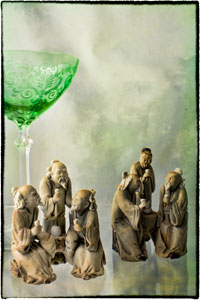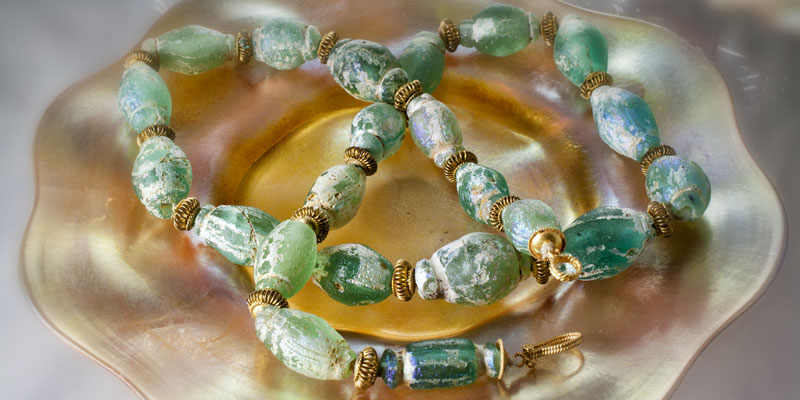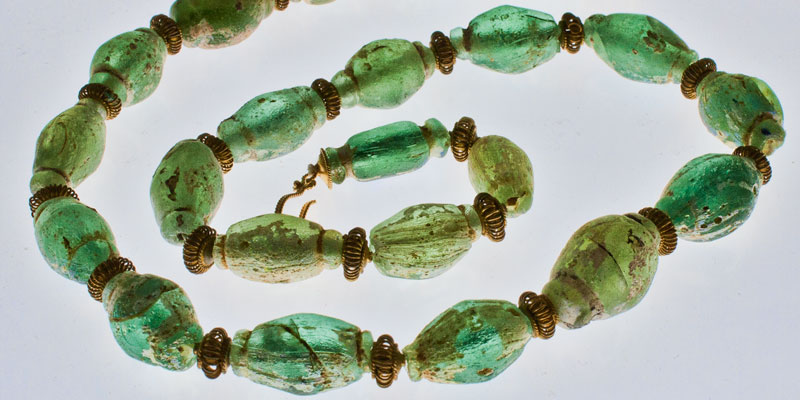mad in pursuit notebook
DISPATCHED FROM THE CROSSROADS
- home >
- favorite themes >
- art & artifacts contents >
- today's entry
 Roman Glass Obsession
Roman Glass Obsession
Anyone who has watched Treasure of the Sierra Madre knows that gold can drive people to insanity. But for me, it's pale green glass. A Coke bottle. Or the wine glasses that my mother kept safe in her china cabinet for decades.
There is something deep and mysterious about green glass that pulls me in -- makes me look and look and look...
So when I started collecting beads, my eyes always jumped to the translucent green. When I began to lose my head over very expensive beads, it was the excavated Roman glass that made me craziest. Centuries in the ground gave the beads an irridescent patina that has been imitated by Tiffany and Carnival Glass manufacturers alike.
A story. It was 1993. Jim and I were having fun with our friends in Manhattan before I was due at a conference on Monday. I had brought down a poster of parrots my friends were hot to buy, so I had cash burning a hole in my pocket -- something like $2500. On Sunday, we visited Samuel Saidian & Sons at the Manhattan Antiques Center. This family of Jewish refugees from Iran had already hooked me on ancient glass beads, either brought with them to America or procured by their cousins still in Iran. This visit was no exception. In their showcase was the most seductive of glass bead necklaces yet. Slight problem: they wanted $4500 for it.

I had to pass.
But I couldn't get them out of my mind, any more than Humphrey Bogart could stop thinking about the gold. Jim and his friends were more familiar with the high stakes collectible world that I was. They knew about pursuing passions... but they also knew about driving hard bargains. Okay, what did I have to lose?

Jim and I arrived outside the door of Saidan & Sons promptly at 11 A.M. on Monday, when they were supposed to open. No one showed up. We paced. And I had plenty of time to reconsider the folly of my plan. But no. At 11:30, one of the sons arrived. I needed to get to my conference so I didn't fool around. "I want that necklace," I said. "But all I have is $2500. Cash." The merchant was good at feigning shocked indignation. But it was easy for me to stand my ground because, in fact, that was all I had. The deal was struck, but he made me promise that if I ever wanted to sell it, I'd come back to him.*
I was high as a kite. When I arrived at my boring child welfare conference, I pulled the necklace out of its velvet bag and showed it to a colleague. He thought I was nuts.

I wonder if enchantment changes your vision -- makes you see a small bead as gigantic and luminous, where others might see only a little hunk of ruination. I'm having trouble photographing my treasure because the photos just look kind of flat. Zooming in and enhancing the contrast and detail helps.
Specifics. The beads are mostly "collared rhomboids" in shape, likely made in the 1st or 2nd century A.D. somewhere in the Roman empire. Since my source was Iranian, I'll wager they were traded to Iran. Centuries of burial pitted an striated the glass and gave it the dense iridescent patina. My dealer told me that the gold spacers were of later Byzantine origin, but who knows.
The top photo shows the necklace on a small Tiffany saucer. Louis Comfort Tiffany worked to reproduced the glow of ancient glass in his modern pieces. The middle photo shows the necklace backlit, to show off its translucency. The third is a macro shot, emphasizing the patina.
---
*I checked the Saidian & Sons website. They must have run out of ancient beads, since it looks like they are specializing now in fine jewelry from later centuries.
Jan 9, 2012


